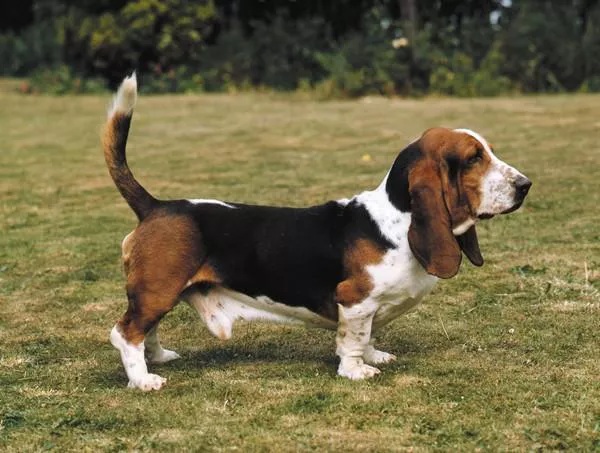Breed Overview and Historical Background
The European Basset Hound, also known as the European basset or simply the Basset Hound, is a distinctive and beloved dog breed renowned for its long ears, droopy eyes, and endearing personality. Originally developed in France, the Basset Hound’s history can be traced back to the 6th century when it was selectively bred from ancient scent hounds. These hounds were favored for their exceptional sense of smell and hunting capabilities, particularly in trailing small game like rabbits and hares. Over the centuries, the Basset Hound became increasingly popular across Europe, eventually making its way to various parts of the world.
Physical Characteristics and Appearance
The European Basset Hound is a medium to large-sized dog with a sturdy and well-balanced body. They typically stand between 11 to 15 inches at the shoulder and weigh anywhere from 40 to 65 pounds, with males usually being larger than females. Their most distinguishing features are their long, pendulous ears, which can measure up to one-third of their body length. The breed’s eyes are large, expressive, and slightly droopy, giving them an irresistibly sad and soulful look. Their coat is short, dense, and comes in various color combinations, including tricolor (black, white, and tan), lemon and white, red and white, or black and white.
Temperament and Personality Traits
Known for their friendly and affectionate nature, European Basset Hounds are renowned for being wonderful family pets and companion animals. They are gentle, patient, and get along well with children and other pets, making them an ideal choice for households with multiple furry friends. Their even temperament and sociable disposition also make them a good fit for therapy work, where they can provide comfort and support to those in need.
Although Basset Hounds are generally easy-going, they have a strong hunting instinct, which can sometimes lead them to follow their noses when they catch an interesting scent. For this reason, it is crucial to keep them on a leash or within a secure and enclosed area during outdoor activities. Training and consistent positive reinforcement are essential to help curb any stubborn tendencies and ensure they respond reliably to commands.
Exercise and Grooming Needs
Despite their low, lumbering appearance, European Basset Hounds require regular exercise to maintain their overall health and prevent obesity. Daily walks and playtime in a safely enclosed area are necessary to keep them physically and mentally stimulated. It’s important to note that excessive exercise, especially on hard surfaces or stairs, should be avoided due to their long backs, which can be prone to injury.
Grooming the European Basset Hound is relatively straightforward, thanks to their short and smooth coat. Regular brushing, typically once or twice a week, helps to remove loose hair and keep their coat looking neat. Additionally, ear cleaning is essential to prevent ear infections, as their long and droopy ears can trap moisture and debris.
Health Considerations
Like all dog breeds, the European Basset Hound is susceptible to certain health issues, some of which are related to their distinctive physical characteristics. Their long, heavy ears can trap moisture, leading to ear infections, so regular cleaning and inspection are crucial. Additionally, their deep chests may make them more prone to bloat, a serious condition that requires immediate veterinary attention.
Basset Hounds are also susceptible to certain hereditary conditions, including hip dysplasia, elbow dysplasia, and eye problems. Reputable breeders perform health screenings on their breeding dogs to reduce the risk of passing on these genetic issues to their offspring.
Finding a Reputable Breeder
When considering bringing a European Basset Hound into your family, it is essential to find a reputable breeder who prioritizes the health and well-being of their dogs. Reputable breeders adhere to ethical breeding practices, perform health screenings on their breeding dogs, and provide a nurturing environment for their puppies.
Prospective owners should visit the breeder’s facilities, meet the breeding dogs and puppies in person, and ask any questions they may have about the breed and the breeder’s practices. A reputable breeder will be happy to provide references and share information about the breed’s temperament, care requirements, and potential health concerns.
Adopt, Don’t Shop
While purchasing a European Basset Hound from a reputable breeder is one option, another equally viable and commendable choice is adoption. Many Basset Hounds find themselves in need of loving homes, and adopting a rescue dog can be a rewarding and life-changing experience. Numerous breed-specific rescue organizations and animal shelters exist, providing the opportunity to give a second chance to a deserving dog.
Conclusion
The European Basset Hound is a delightful breed cherished for its unique appearance and gentle disposition. With their affectionate and friendly nature, they make excellent family pets and loyal companions. Despite their hunting instincts, they can thrive in various living situations as long as their exercise and grooming needs are met. Responsible breeding and adoption practices are essential to ensure the well-being and continued existence of this beloved breed for generations to come. Whether obtained through a reputable breeder or a rescue organization, the European Basset Hound is sure to bring joy and companionship to any home fortunate enough to welcome them into their hearts.


